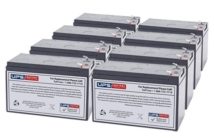Absorbed electrolyte –is the electrolyte in a battery absorbed in an AGM (absorbent glass mat) between the plates.
Absorbed electrolyte cell–is usually a VRLA (valve-regulated sealed lead-acid) battery that is utilizing absorbed electrolyte.
Absorbed Glass Mat (AGM) battery – is a battery known as dry cell or starved electrolyte because the fiber glass mat has no excess fluid. It uses a blotter type separator between plates. The absorbent glass mat separator absorbs the free liquid electrolyte.
Accessories– are components like flame-arrestor vents, connectors, hardware, and cell numbers required to complete the installation of a battery.
Activation charge – is the process of introducing electrolyte and charging a dry-charged battery to make it functional.
Active material–is the material in the electrodes in a lead-acid battery which is involved in the electrochemical reaction to produce a current when the cell discharges but is restored during the charge process.
Actual capacity – is the total ampere-hours withdrawn from a cell based on initial cell temperature, discharge rate, initial-state-of-charge, and end voltage.
Ambient temperature – is the average room temperature that comes into contact with the battery.
Anode–is an electrode where the positive electrical charge flows into a polarized electrical device. During discharge, the anode is the negative terminal because it is where the current flows but during recharge, the anode is the positive terminal because it receives the current from an external generator.
As found (condition) – is the term used to test the battery without performing checks to reflect the maintenance practice followed for installation.
Average temperature–is the temperature of each individual cell.
Average voltage – is the average voltage of battery cells, including average float voltage, and average discharge voltage.
Battery – two or more cells connected in series, parallel, or both to provide the required current or voltage levels.
Battery charger–is also known as a rectifier. It is a device used to restore the charge of secondary batteries.
Battery duty cycle–is the battery load expected to supply for a specific period of time.
Battery monitor – is a piece of an apparatus used to monitor the different parameters of a battery such as temperature, battery voltage, and individual cell voltage.
Battery nominal voltage – is a reference used to indicate the voltage of the battery (example 12-volts or 24-volts).
Battery rack – is a steel with corrosion-resistant coating stand or structure used to support a group of cells.
Boost charge – any length of overcharge.
Cathode – is an electrode where the current flows out. During discharge, the cathode is the positive terminal because this is where the current flows out, but during recharge, it is the negative terminal because this is where the current exits the device and returns to the external generator.
Carbonization – is a condition where the electrolyte is contaminated with potassium carbonate, which influences its performance.
Capacity– is the quantity of electrical energy assigned by the manufacturer which is measured in ampere-hours or watt-hours produced by a battery during discharge.
Cell – is an electrochemical unit used to receive, store, and deliver electrical energy characterized by a cathode and anode.
Cell temperature – is the operating temperature of a cell. The reference cell temperature in the U.S. is 25°C (77°F).
Charge – is the process of the conversion of electrical energy into chemical energy within a secondary cell.
Closed-circuit voltage – is the discharge voltage of a cell.
Constant current charge – is the uniform current supply during charging regardless of the battery temperature or state of charge.
Constant potential charge – is a charge where the potential voltage at the battery output terminal is maintained at a constant value.
Cycle – is the discharge followed by the recharge of a battery.
Density – is the weight of the electrolyte volume at a specified temperature measure in watt-hours per cubic inch.
Depth of discharge – is used to describe how deeply the battery is discharged based on the ratio of the electricity’s capacity removed during discharge. For example, if the battery is 100 percent fully charged the DOD is 0 percent. If the battery has delivered 30 percent of its energy, the DOD is 50 percent.
Discharge – is an operational state where the chemical energy is converted to electrical energy within a cell.
Discharge rate – is the current rate in amperes, which is delivered by the battery.
Dry-charged cell – is a cell in a charge state that is assembled with dry plates ready to be activated when the electrolyte is added.
Efficiency – is the percentage of the electrochemical efficiency expressed in ampere-hour output and ampere-hour input required to restore the initial state of charge.
Electrode – is a conductor where the electrical current pass from a power source to a device.
Electrolyte – is a conductive chemical like gel, salt or acidic solution where the flow of electricity takes place within a battery.
Element – is the assembled parts of the positive and negative separators and plates.
End cell – is a cell that can be removed from or added to a battery circuit to adjust the voltage.
End voltage – is a cell voltage indicating the end limit of a discharge.
Energy density – is the ratio of the cell or battery’s energy to its volume.
Flame-arrestor belt – is a cell venting device that prevents the propagation of an external flame into the cell.
Flame-retardant material –is a material capable of limiting the propagation of a fire beyond the source that initiated it.
Float current –is the current draw by a cell that is float charged.
Float voltage – is the voltage applied during the full-float operation.
Flooded cell – is a cell design characterized by excess of free electrolyte where the electrolyte can freely exit the vent.
Freshening charge – is a charge given to a battery after storage or non-usage.
Full-float operation – is the operation of DC system with battery, battery charger, and load connector in parallel with the battery charger supplying the normal DC load plus the charging and self-charging required by the battery.
Fully charged – is a condition following a constant current charge.
Gassing – the evolution of oxygen and hydrogen from lead-acid batteries during periods of charging or overcharging resulting to electrolysis of the water in the electrolyte.
Gelled electrolyte – is the electrolyte that has been immobilized with the addition of gelling agent.
Gelled electrolyte cell – a cell that uses gelled electrolyte like VRLA or lead-acid.
General-purpose cell – is a cell designed to supply high-current duty cycle for a short period of time followed by a low current for a long period of time.
Grid – is a lead alloy framework that supports the active materials that provide the conductive path for the electric current during the charging and discharging of the battery.
High level line – is a line at the side of the jar that shows the maximum level of electrolyte required in a cell.
High-performance cell – is a cell designed to supply a high-current duty cycle for a short period of time.
Hit – is an indicator showing that the battery has been discharged.
Hit counter – is a device used to record the number of battery discharges.
Hydration (lead-acid cell) – is a condition caused by discharging and unable to charge in a timely manner.
Immobilized electrolyte – is an electrolyte retained by the absorbent mat or gel.
Initial charge – is the charge given to the new battery when it is first installed, or before it is placed in service.
Initial voltage – is a closed-circuit voltage at the beginning of a discharge or when the current is drawn from the battery.
Integrity test – is a test used to detect possible conduction path problems.
Inter-cell connection resistance – is the total electrical resistance of the terminals between two electrically connected cells.
Inter-cell connector – is an electrical conductor wire, strap, or buss bar used to connect two individual adjacent cells in a parallel or series in the same rack.
Inter-cell connector safety cover – is an insulated cover placed on top of the inter-cell connector to prevent cell short circuit or accidental contact by the personnel.
Inter-rack connector – is an electrical conductor used to connect cells on two separate racks.
Internal impedance – is the cell resistance to an alternating current of specific frequency.
Internal resistance – is the cell’s resistance to an electric current flow within a cell.
Internal voltage drop – is the passing of current through the cell.
Jar – is a thermoplastic, rubber, or metal container that holds the cell or group of cells.
Jar-to-cover seal – is the seal at the interface of the jar.
Lead-acid cell – is a secondary cell with sulfuric acid solution in water as an electrolyte.
Level line – is the line used to indicate the cell’s minimum or maximum electrolyte level.
Local action – is the internal loss of the battery on float charge or open circuit.
Long duration cell – is a cell designed to supply a duty cycle requiring a low current for a long period of time.
Low level line – is a line on the side of the jar that represents the minimum level of electrolyte required in a cell.
Modified-plante plate – is a lead alloy grid containing holes where pure lead corrugated strips are fitted.
Multi-cell container – is a multi compartment container where each containing have individual cells.
Multi-cell unit – is a multi-cell container where cells are installed.
Negative plate –is the electrode where current flows from the external circuit during discharge.
Negative terminal – is the terminal where the positive current flows in the external circuit.
NiCad battery – is a sealed storage battery with cadmium cathode, nickel anode, and alkaline electrolyte.
Nominal gravity – is the specific gravity of the electrode to determine the capacity of the battery when it is fully charged.
Open-circuit voltage – is the voltage of a cell without current flow in either direction.
Overcharge – is the continued charging of the battery after the full capacity has been reached after recharge.
Oxygen index – is the minimum percentage of the volume of nitrogen and oxygen concentration enough to support the flaming combustion of materials in room temperature.
Oxygen recombination – is the process where the oxygen generated in a positive electrode recombines with the hydrogen in a negative electrode.
Oxygen recombination efficiency – is the ratio of the oxygen quantity recombined to the total of generated oxygen.
Parallel – is the interconnection of the cells where all terminals are connected.
Parallel strings – is the interconnection of two or more strings where like terminals of each string are connected.
Pasted plate – is a grid with active materials applied as paste.
Performance test – is a constant current capacity test done after the battery is placed in service to detect any changes in capacity.
Pilot cell – are cells within the battery selected to represent the state of the entire battery.
Plante plate – is a solid lead plate used in lead-acid battery where the active materials are electrochemically formed directly from a lead substance rather than pasted.
Plate – is also known as an electrode. It is an assembly of active materials on frame or support grid or framework grid.
Pocket plate – is a perforated metal support pocket usually used in nickel-cadmium cells where active materials are held.
Point (of specific gravity) – is one-thousandth of SG (specific gravity).
Polarization – is the voltage change at a cell terminal when specified current is flowing into it.
Positive plate – is the electrode where the current flows to the external circuit during discharge.
Positive terminal – is the terminal where the positive electric charge flows through the electrical circuit to the negative terminal during discharge.
Power density – is the ratio of the cell’s power to its weight or volume.
Rated capacity – is the ampere-hour capacity assigned to a cell for a given discharge time and the specified electrolyte temperature to a given end-of-charge voltage.
Recombination vent – is the vent where most of the gasses escaping the vent are recombined and returned to the cell as water.
Reference electrode – is an electrode with producible potential.
Retainer – is a material used to prevent the loss of active materials.
Reversal – is the normal polarity charging of the cell.
Rundown test – is a partial voltage discharge test.
Sealed lead-acid (SLA) battery – are a non-spillable and maintenance-free valve regulated battery with vents that cannot be removed.
Secondary cell – is an electrochemical cell capable of charging and discharging.
Secondary battery – are two or more electronically connected secondary cells.
Sediment – is an active material shed from the positive and negative battery plates invented cell and settles at the bottom of the plates.
Self-discharge rate – is the amount of capacity reductions per unit of time resulting from discharge.
Separator – is an ionic non-conductive and permeable spacer to prevent between plates and polarity within a cell.
Series – is the interconnection of battery capacity from the positive terminal of the first to the negative terminal of the second.
Service life – is the period which the capacity of the fully charged battery is capable of delivering the specified percentage of capacity rate.
Shipping vent – is the vent placed in the cell for shipping purposes.
Specific gravity – is the ratio of electrolyte volume weight to the equal volume weight of water at a specified temperature.
Standby battery – is the vent placed in the cell for shipping it.
State-of-charge – is the actual capacity of the cell expressed as the percentage of its capacity.
Stationary battery – is a secondary battery designed to service in a permanent position and fixed on a rack, stand, or cabinet.
Step rack – is a rack where cells are placed in a different step arrangement levels.
Strap – is a component in a cell where the plates of the same polarity are joined together.
String – refers to a number of cells that are connected in a series to form a battery.
Sulphation (lead-acid-cell) – is a state where the battery has developed an abnormal amount of sulphate causing impairment in its capacity. This is different from the sulphate that occurs during discharge.
Taper charge – is the decrease of voltage and current over the recharge period.
Terminal – is the part of the cell where the external circuit is connected.
Thermal runaway – is a condition where the battery generates more heat than it can dissipate and ultimately destroys itself. This is usually the result of float charging in an environment with shorted cells or less ventilation.
Tier rack – is a multi-level rack where cells are placed above each other.
Trickle charge – is a very low constant charge given to a battery to maintain it in a fully charged state.
Valve – is a sealed mechanism to allow the controlled release of gasses developed within the cell.
Valve-regulated sealed lead-acid-cell – is a sealed cell and fitted with a valve that opens to vent whenever the set amount of internal pressure exceeds the atmospheric pressure.
Vent – is a device to allowing the free escape of gasses from within the cell to prevent ignition by an outside source.
Voltage efficiency – is the ratio of the average voltage during discharge to the average voltage during recharge.
Voltage spread – describes the difference between the highest and lowest individual cell voltage of the battery.
Wet-cell – is a cell characterized by an excess of free electrolyte that can exit freely exit through a vent.



